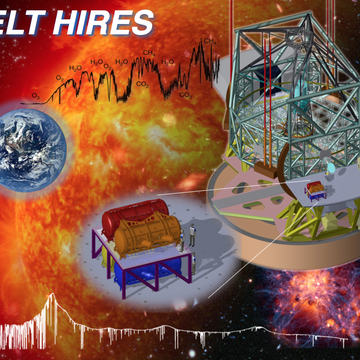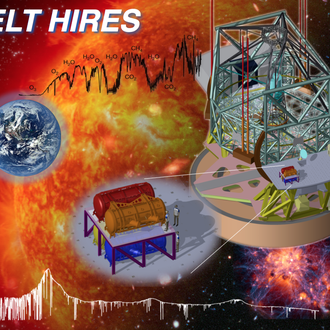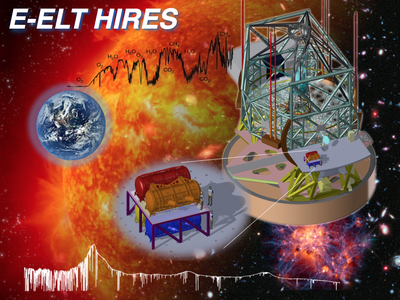HIRES: The world’s biggest telescope gets the world’s best instrumentation
Scientists and engineers have begun mapping out the detailed specifications for the High Resolution Spectrograph HIRES that will be part of the instrument suite on ESO’s forthcoming European Extremely Large Telescope (E-ELT). Besides the Multi-Object Spectrograph MOS HIRES will be one of the world-leading workhorse instruments on what will be the world’s largest telescope. The contract to begin design studies for HIRES was signed on 22 March 2016 by ESO and the HIRES consortium, led by INAF.
High resolution spectroscopy simultaneously covering ultraviolet, optical and infrared wavelengths is new in astronomical research and will open new windows in our understanding of several hot topics of modern stellar and extragalactic astrophysics. With a spectral resolution of R=100,000 and a wavelength coverage from 350nm to 2500nm, E-ELT HIRES will be an instrument capable of providing unique breakthroughs in the fields of habitable exoplanets, star and planet formation, physics and evolution of stars and galaxies, and cosmology and fundamental physics. Among the prime science goals of HIRES will be the detection of biosignatures from planets around other Suns and contribute to the search for extraterrestrial life. E-ELT HIRES also offers the possibility of paradigm-changing contributions to fundamental physics due to the precision afforded by Laser Frequency Comb calibrated high-fidelity spectroscopy.
The HIRES-consortium is among the largest ever to collaborate in the production of astronomical instruments, illustrating the multinational efforts involved in making these spectrographs. Instruments like HIRES or MOS type feature in the essential toolbox of every modern telescope — these world-leading examples will make the most of the enormous light-gathering power of the E-ELT’s 39-metre main mirror, giving them a performance second to none.
The HIRES Consortium consists of 12 countries (Brazil, Chile, Denmark, France, Germany, Italy, Poland, Portugal, Spain, Sweden, Switzerland, United Kingdom). The Italian National Institute for Astrophysics (INAF) will be the lead technical Institute within the Consortium. Germany is represented by the Leibniz-Institute for Astrophysics Potsdam (AIP) and Prof. Klaus G. Strassmeier is the coordinator and Co-I of HIRES and a member of its Board, Michael Weber is deputy instrument scientist. The German contributions to HIRES will include the entire Stokes polarimeter and its focal station (Potsdam), the blue-ultraviolet component of the visible spectrograph (Potsdam, Heidelberg, Göttingen), the calibration environment (Göttingen, Tautenburg), and the fibre link (Potsdam, Heidelberg).
The German contributions to HIRES are supported by the BMBF-program „Erdgebundene Astrophysik und Astroteilchenphysik“.
Science contacts: Prof. Dr. Klaus G. Strassmeier, kstrassmeier@aip.de and Dr. Michael Weber, mweber@aip.de
Media contact: Dr. Janine Fohlmeister, presse@aip.de, +49 331-7499 802
Scientists and engineers have begun mapping out the detailed specifications for the High Resolution Spectrograph HIRES that will be part of the instrument suite on ESO’s forthcoming European Extremely Large Telescope (E-ELT). Besides the Multi-Object Spectrograph MOS HIRES will be one of the world-leading workhorse instruments on what will be the world’s largest telescope. The contract to begin design studies for HIRES was signed on 22 March 2016 by ESO and the HIRES consortium, led by INAF.
High resolution spectroscopy simultaneously covering ultraviolet, optical and infrared wavelengths is new in astronomical research and will open new windows in our understanding of several hot topics of modern stellar and extragalactic astrophysics. With a spectral resolution of R=100,000 and a wavelength coverage from 350nm to 2500nm, E-ELT HIRES will be an instrument capable of providing unique breakthroughs in the fields of habitable exoplanets, star and planet formation, physics and evolution of stars and galaxies, and cosmology and fundamental physics. Among the prime science goals of HIRES will be the detection of biosignatures from planets around other Suns and contribute to the search for extraterrestrial life. E-ELT HIRES also offers the possibility of paradigm-changing contributions to fundamental physics due to the precision afforded by Laser Frequency Comb calibrated high-fidelity spectroscopy.
The HIRES-consortium is among the largest ever to collaborate in the production of astronomical instruments, illustrating the multinational efforts involved in making these spectrographs. Instruments like HIRES or MOS type feature in the essential toolbox of every modern telescope — these world-leading examples will make the most of the enormous light-gathering power of the E-ELT’s 39-metre main mirror, giving them a performance second to none.
The HIRES Consortium consists of 12 countries (Brazil, Chile, Denmark, France, Germany, Italy, Poland, Portugal, Spain, Sweden, Switzerland, United Kingdom). The Italian National Institute for Astrophysics (INAF) will be the lead technical Institute within the Consortium. Germany is represented by the Leibniz-Institute for Astrophysics Potsdam (AIP) and Prof. Klaus G. Strassmeier is the coordinator and Co-I of HIRES and a member of its Board, Michael Weber is deputy instrument scientist. The German contributions to HIRES will include the entire Stokes polarimeter and its focal station (Potsdam), the blue-ultraviolet component of the visible spectrograph (Potsdam, Heidelberg, Göttingen), the calibration environment (Göttingen, Tautenburg), and the fibre link (Potsdam, Heidelberg).
The German contributions to HIRES are supported by the BMBF-program „Erdgebundene Astrophysik und Astroteilchenphysik“.
Science contacts: Prof. Dr. Klaus G. Strassmeier, kstrassmeier@aip.de and Dr. Michael Weber, mweber@aip.de
Media contact: Dr. Janine Fohlmeister, presse@aip.de, +49 331-7499 802
Images
Illustration of the HIRES instrument and its adressed scientific goals.
Big screen size [1000 x 750, 1.3 MB]
Original size [1160 x 870, 1.6 MB]





